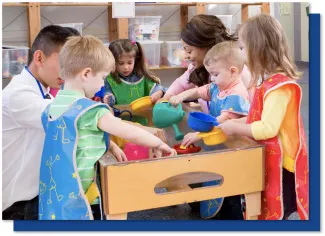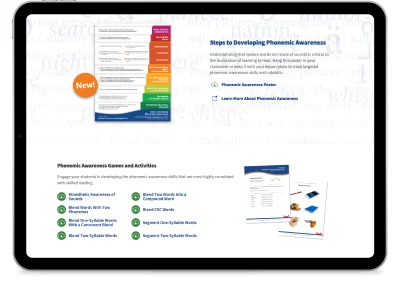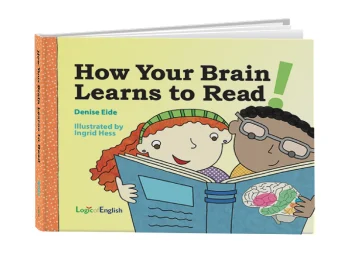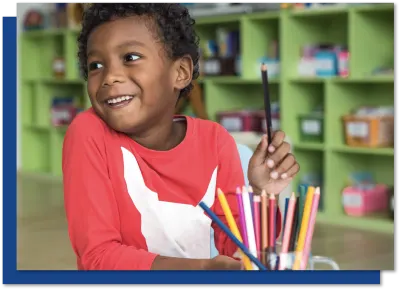Skilled reading in elementary school depends on developing strong language comprehension skills. That is why, in early childhood education, it is important to:

- Read to children - Books include vocabulary and sentence structure not commonly used in daily speech.
- Engage them in conversation - Talk about the books you read together, encourage them to share their ideas and get involved in their play! You are building their oral language skills.
- Expose them to a wide variety of topics - Learning about plants, animals, space, types of jobs, vehicles, buildings, places—the list goes on and on—exposes children to new ideas and helps to develop their vocabulary.
Early childhood is also an ideal time to introduce children to early decoding skills: phonemic awareness and systematic phonics. The goal is to spark their curiosity about written words, build a connection that all words are made up of sounds, develop an understanding that the letters on the page represent sounds and build their confidence that they will be able to decode the words to create meaning.
Phonemic Awareness

Phonemic awareness is the understanding that spoken words are made up of sounds. No print is needed! Explain to children that every word can be “unglued into sounds.” Show examples by saying words with a short pause after each sound, such as /d-o-g/, and then saying the word “dog.” Segment the name of an object and ask the child to find the object around them. For example, /r-u-g/, /ch-ai-r/ and /l-igh-t/. See our Phonemic Awareness Free Resources for more phonemic awareness game ideas.
Systematic Phonics
Teach young students their ABCs while also introducing them to the idea that phonograms are pictures of sounds. When introducing letters, say the name, followed by the sound(s). Yes! Introduce all the sounds from the beginning.
- Listen to phonogram songs! Search for Doodling Dragons, Whistling Whales and Knitting Knights on all the major streaming services. 🎶
- Create phonogram posters! Write a phonogram on a piece of paper or a poster. Become detectives looking for words that include the phonogram. Add them to the poster. Write the phonogram in a different color from the rest of the word! You can even add pictures. ✂️
-
 Name a Phonogram of the Day or Week! If your Phonogram of the Week is S, introduce both sounds: /s/ and /z/. Read books about snakes and roses, seals and deserts. Wear sandals and slippers. Eat star fruit, soup, raisins and dessert. Plant seeds. Learn about the four seasons. Listen for /s/ and /z/ in each of the words. Add them to your phonogram posters! Use Phinder to help find words for each of the sounds. 🧦🌟🥣
Name a Phonogram of the Day or Week! If your Phonogram of the Week is S, introduce both sounds: /s/ and /z/. Read books about snakes and roses, seals and deserts. Wear sandals and slippers. Eat star fruit, soup, raisins and dessert. Plant seeds. Learn about the four seasons. Listen for /s/ and /z/ in each of the words. Add them to your phonogram posters! Use Phinder to help find words for each of the sounds. 🧦🌟🥣 - Learn how to write phonograms using large-motor movements! Write the phonograms in salt boxes, with shaving cream, with finger paint and in the sand! Neuroscience shows that teaching kids how to write the phonograms helps to activate the letterbox! ☝️
- Play phonogram games - Write phonograms on the ground and play hopscotch, saying the sounds while you jump from phonogram to phonogram. Play phonogram bingo. When children learn through play, they ask for more, not even realizing they are internalizing the keys to uncovering English words! See the Logic of English Game Book for more ideas! 🎲🏀🧩
-
Decode words with the phonograms they have learned! Once they know a vowel and a few consonants, begin to sound out words together! If a child asks how to read a word they have yet to learn the phonograms for, model how to sound it out. Underline multi-letter phonograms and explain that those letters are working together to make one sound! ✅


Empower Children by Knowing How Their Brain Learns To Read.
Read How Your Brain Learns to Read and discover together how phonemic awareness and systematic phonics work together in our brains to create the illusion of reading whole words. Reread to develop their phonemic awareness skills. Reread again and look for hidden words throughout the book that they will now be able to decode with the concepts introduced in the book.

Spark the Joy of Learning!
Respect their attention spans and find creative ways to engage them in the learning process. When we teach young children through play and games, we are helping them to develop the confidence and curiosity that will become a foundation for all that they learn.








